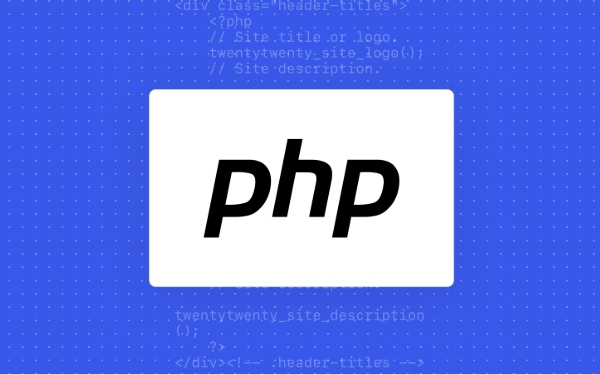PHP中的資源管理:'資源”類型的生命週期
PHP資源的生命週期分為三個階段:1. 資源創建,通過fopen、curl_init等函數獲取外部系統句柄;2. 資源使用,將資源傳遞給相關函數進行操作,PHP通過資源ID映射到底層系統結構;3. 資源銷毀,應優先手動調用fclose、curl_close等函數釋放資源,避免依賴自動垃圾回收,以防文件描述符耗盡。最佳實踐包括:始終顯式關閉資源、使用try...finally確保清理、優先選用支持__destruct的PDO等對象封裝、避免全局存儲資源,並可通過get_resources()監控活動資源以排查洩漏。總之,應做到獲取晚、釋放早、始終清理。

In PHP, the resource type is a special variable that holds a reference to an external resource—typically something outside the PHP runtime, like a file handle, database connection, or image canvas. Understanding how resources are created, used, and cleaned up is key to writing efficient and leak-free PHP code.

Unlike standard data types (integers, strings, arrays), resources represent stateful connections or handles to system-level entities. Because of this, their lifecycle is tightly tied to external systems and proper cleanup is critical.
Here's how the lifecycle of a PHP resource typically works:

1. Resource Creation: Acquiring External Handles
Resources are created when PHP functions request a system-level resource from the operating system or an extension.
Common examples include:

$handle = fopen('data.txt', 'r'); // File handle $connection = curl_init(); // cURL session $imagick = imagick_new_image(); // Image resource (via Imagick) $pdo = mysqli_connect('localhost', ...); // MySQL connection
At this point, PHP allocates a resource ID internally and associates it with the underlying system resource. The variable $handle doesn't contain the file data—it's a pointer to an open file descriptor managed by the OS.
⚠️ Not all extensions use resources the same way. Modern extensions like
PDOormysqli(in object mode) use objects instead of raw resources for better encapsulation.
2. Resource Usage: Interacting with the Handle
Once created, you pass the resource to other functions that operate on it:
while (!feof($handle)) {
$line = fgets($handle);
echo $line;
}These functions use the resource ID to look up the actual system handle and perform operations (eg, reading bytes from a file). The resource remains active as long as it's referenced by a variable and hasn't been explicitly closed.
Internally, PHP maintains a lookup table mapping resource IDs to actual C-level structures (like FILE* pointers in C).
3. Resource Destruction: Freeing the Handle
Resources should be explicitly freed when no longer needed to avoid leaks.
Manual Cleanup
Use the appropriate close/free function:
fclose($handle); // Close file curl_close($connection); // Terminate cURL session
After calling fclose() , the resource becomes invalid. Using it afterward triggers a warning:
echo fgets($handle); // Warning: supplied resource is not a valid stream
Automatic Cleanup (Garbage Collection)
If you don't close a resource manually, PHP will attempt to clean it up when the variable goes out of scope or at the end of the request:
function readFirstLine() {
$f = fopen('data.txt', 'r');
$line = fgets($f);
return $line;
} // $f goes out of scope → PHP closes the file handle automaticallyHowever, relying on garbage collection is risky , especially in long-running scripts or loops:
for ($i = 0; $i < 1000; $i ) {
$h = fopen("file_$i.txt", 'r');
// Process file...
// No fclose() → you may hit "Too many open files" error
}Even though PHP cleans up at script end, the OS has limits on concurrent open file descriptors. You can exhaust them during execution.
4. Best Practices for Managing Resources
To avoid leaks and ensure robust code:
✅ Always close resources explicitly after use:
$handle = fopen('data.txt', 'r'); // ... use it fclose($handle);
✅ Use
try ... finallypatterns (ortry ... catchwith cleanup) in critical sections:$handle = fopen('data.txt', 'r'); if ($handle) { try { // Process file } finally { fclose($handle); // Guaranteed cleanup } }✅ Prefer objects over raw resources where possible (eg,
PDO,mysqli,GuzzleHttp\Client). They support destructors (__destruct()) for more predictable cleanup.✅ Monitor resource usage in long-running scripts:
echo gc_collect_cycles(); // Force GC var_dump(get_resources()); // List all active resources
❌ Avoid storing resources in global/static variables unless absolutely necessary—they're harder to track and clean.
Bonus: Inspecting Resources
You can check a variable's resource type and ID:
$handle = fopen('data.txt', 'r'); var_dump($handle); // resource(5) of type (stream) get_resource_type($handle); // Returns "stream" is_resource($handle); // Returns true
get_resources() (PHP 7.0 ) returns all currently active resources:
foreach (get_resources() as $res) {
echo get_resource_type($res) . "\n"; // eg, "curl", "mysql link"
}Useful for debugging leaks.
Basically, just remember: acquire late, release early, and always clean up . Resources are bridges to the outside world—don't leave them open.
以上是PHP中的資源管理:'資源”類型的生命週期的詳細內容。更多資訊請關注PHP中文網其他相關文章!

熱AI工具

Undress AI Tool
免費脫衣圖片

Undresser.AI Undress
人工智慧驅動的應用程序,用於創建逼真的裸體照片

AI Clothes Remover
用於從照片中去除衣服的線上人工智慧工具。

Clothoff.io
AI脫衣器

Video Face Swap
使用我們完全免費的人工智慧換臉工具,輕鬆在任何影片中換臉!

熱門文章

熱工具

記事本++7.3.1
好用且免費的程式碼編輯器

SublimeText3漢化版
中文版,非常好用

禪工作室 13.0.1
強大的PHP整合開發環境

Dreamweaver CS6
視覺化網頁開發工具

SublimeText3 Mac版
神級程式碼編輯軟體(SublimeText3)
 使用PHP 8的工會類型對您的代碼庫進行現代化現代化
Jul 27, 2025 am 04:33 AM
使用PHP 8的工會類型對您的代碼庫進行現代化現代化
Jul 27, 2025 am 04:33 AM
UpgradePHP7.xcodebasestoPHP8 byreplacingPHPDoc-suggestedtypeslike@paramstring|intwithnativeuniontypessuchasstring|intforparametersandreturntypes,whichimprovestypesafetyandclarity;2.Applyuniontypestomixedinputparameters(e.g.,int|stringforIDs),nullable
 PHP 8.1枚舉:一種新型類型安全常數的範式
Jul 28, 2025 am 04:43 AM
PHP 8.1枚舉:一種新型類型安全常數的範式
Jul 28, 2025 am 04:43 AM
PHP8.1引入的Enums提供了類型安全的常量集合,解決了魔法值問題;1.使用enum定義固定常量,如Status::Draft,確保只有預定義值可用;2.通過BackedEnums將枚舉綁定到字符串或整數,支持from()和tryFrom()在標量與枚舉間轉換;3.枚舉可定義方法和行為,如color()和isEditable(),增強業務邏輯封裝;4.適用於狀態、配置等靜態場景,不適用於動態數據;5.可實現UnitEnum或BackedEnum接口進行類型約束,提升代碼健壯性和IDE支持,是
 精度的危險:處理PHP中的浮點數
Jul 26, 2025 am 09:41 AM
精度的危險:處理PHP中的浮點數
Jul 26, 2025 am 09:41 AM
0.1 0.2!==0.3inPHPduetobinaryfloating-pointprecisionlimitations,sodevelopersmustavoiddirectcomparisonsanduseepsilon-basedchecks,employBCMathorGMPforexactarithmetic,storecurrencyinintegerswhenpossible,formatoutputcarefully,andneverrelyonfloatprecision
 PHP的二元性:導航鬆散鍵入與嚴格類型聲明
Jul 26, 2025 am 09:42 AM
PHP的二元性:導航鬆散鍵入與嚴格類型聲明
Jul 26, 2025 am 09:42 AM
PHP支持鬆散類型和嚴格類型並存,這是其從腳本語言演進為現代編程語言的核心特徵。 1.鬆散類型適合快速原型開發、處理動態用戶輸入或對接外部API,但存在類型隱式轉換風險、調試困難和工具支持弱的問題。 2.嚴格類型通過declare(strict_types=1)啟用,可提前發現錯誤、提升代碼可讀性和IDE支持,適用於核心業務邏輯、團隊協作和對數據完整性要求高的場景。 3.實際開發中應混合使用:默認啟用嚴格類型,僅在必要時在輸入邊界使用鬆散類型,並儘早進行驗證和類型轉換。 4.推薦實踐包括使用PHPSta
 了解``callable''偽型及其實施
Jul 27, 2025 am 04:29 AM
了解``callable''偽型及其實施
Jul 27, 2025 am 04:29 AM
AcalableInphpiSapseDo-typerepresentingyanyvaluethatcanbeinvokedusedthuse()operator,pryperally formimallyforflefflexiblecodeiCodeIncallbackSandHigher-rorderfunctions; themainformsofcallablesare:1)命名functionslunctionsLikefunctionsLikeLike'strlen',2)andormousfunctions(2)andonymousfunctions(封閉),3),3),3),3)
 從'混合到`void':php返回類型聲明的實用指南
Jul 27, 2025 am 12:11 AM
從'混合到`void':php返回類型聲明的實用指南
Jul 27, 2025 am 12:11 AM
returnTypesinphpimProveCoderEliabilitialaryandClarityBysPecifying whatafunctionMustReturn.2.UseBasictyPesLikestring,array,ordatimetoetoEnforCorrectRecturcrectRecturnValuesUnturnvAluesAndCatchErrorSearly.3.applynullabletypespeswith? applynullabletypeswith?
 變量的壽命:PHP的內部' Zval”結構解釋了
Jul 27, 2025 am 03:47 AM
變量的壽命:PHP的內部' Zval”結構解釋了
Jul 27, 2025 am 03:47 AM
PHP使用zval結構管理變量,答案是:1.zval包含值、類型和元數據,大小為16字節;2.類型變化時只需更新聯合體和類型信息;3.複雜類型通過指針引用帶引用計數的結構;4.賦值時採用寫時復制優化內存;5.引用使變量共享同一zval;6.循環引用由專門的垃圾回收器處理。這解釋了PHP變量行為的底層機制。
 PHP中的資源管理:'資源”類型的生命週期
Jul 27, 2025 am 04:30 AM
PHP中的資源管理:'資源”類型的生命週期
Jul 27, 2025 am 04:30 AM
PHP資源的生命週期分為三個階段:1.資源創建,通過fopen、curl_init等函數獲取外部系統句柄;2.資源使用,將資源傳遞給相關函數進行操作,PHP通過資源ID映射到底層系統結構;3.資源銷毀,應優先手動調用fclose、curl_close等函數釋放資源,避免依賴自動垃圾回收,以防文件描述符耗盡。最佳實踐包括:始終顯式關閉資源、使用try...finally確保清理、優先選用支持__destruct的PDO等對象封裝、避免全局存儲資源,並可通過get_resources()監控活動資源







